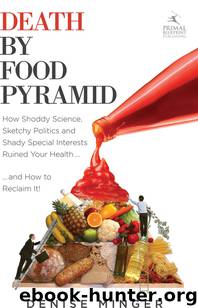Death by Food Pyramid by Denise Minger

Author:Denise Minger [Minger, Denise]
Language: eng
Format: epub, azw3, mobi
Publisher: Primal Nutrition, Inc.
Published: 2013-01-07T00:00:00+00:00
Fig. 10. Harvard Healthy Eating Pyramid
Fig. 11. Harvard Healthy Eating Plate
Like most things sprouting from an Ivy League vine, the Harvard pyramid seems fabulously highbrow and smart—an intelligent revision of the USDA’s blunder, with an enticing European spin. And in many ways, it is. Inspired largely by the Cretan Mediterranean diet and championed by Keys, the Harvard pyramid and plate abolishes the food-industry concessions to keep refined starches on the table.
Grains, the superstar of the USDA’s pyramid, fill less than half a tier instead of stealing the whole show. A new “base” of daily exercise and weight control emphasizes the importance of non-diet components of health. And to some, the Harvard pyramid’s crowning glory is its grand adieu to the lowfat message: it embraces vegetable oils such as olive, canola, soybean, corn, sunflower, and peanut, as well as trans-fat free vegetable margarines. (Animal fats—particularly butter and fatty meats—are still stuffed into the pyramid’s “use sparingly” attic.)
Indeed, Willett doesn’t mince words when explaining why federal diet advice has largely been a failure. In a 2004 interview with PBS’s Frontline, he described the USDA’s food pyramid as “not compatible with good scientific evidence” and “out of date from the day it was printed,” due mainly to its universal condemnation of fat and unscrupulous promotion of starches.85 Likewise, the Harvard School of Public Health’s “Nutrition Source” website notes the USDA’s recommendations were “influenced by people with business interests in the messages the icons sent.”86 Harvard’s spin on the pyramid and plate, by contrast, “are unaffected by businesses and organizations with a stake in their messages.”87
By and large, Harvard’s pyramid and plate do weed out many of the flaws plaguing the USDA’s advice—but they’re still far from perfect. Apart from the issue of individual starch tolerance, which we’ll hash out in Herbivore’s Dilemma, one glaring and potentially dangerous issue stands out: the Harvard pyramid’s clear endorsement of industrial oils, which contain a level of omega-6 fats unknown to the human body until just the last century.
Willett, a well-known champion of such oils (and whose vocal, pro-omega-6 views don’t always mesh with those of other researchers), felt that American heart disease trends are fabulously supportive of the move towards higher polyunsaturated fat (PUFA) intake. In describing the ‘70s-era dietary advice to replace saturated fat with polyunsaturated fat, Willett claims the subsequent PUFA increase was probably the biggest reason American heart disease rates dropped in the ’70s and early ’80s.88 (His observation is a shining example of the “correlation isn’t causation” rule: during the same period heart disease mortality began its rapid falloff, cigarette smoking had also entered its decline—throwing some uncertainty on the claim that PUFA intake was really the driving force.89)
It’s important to note that the Harvard pyramid’s highly vegetable-oiled base is a theoretical addition rather than a component of any traditional, health-promoting diet of the Mediterranean (or anywhere else, for that matter). While olive oil was certainly a highlight of the menus there, corn oil, soybean oil, cottonseed oil, and other fats requiring heavy industrial processing arrived only in more recent decades.
Download
Death by Food Pyramid by Denise Minger.azw3
Death by Food Pyramid by Denise Minger.mobi
This site does not store any files on its server. We only index and link to content provided by other sites. Please contact the content providers to delete copyright contents if any and email us, we'll remove relevant links or contents immediately.
How to Be a Bawse: A Guide to Conquering Life by Lilly Singh(7162)
Deep Work by Cal Newport(6587)
The Longevity Diet by Valter Longo(4864)
The Fat Loss Plan by Joe Wicks(4629)
The Four-Pack Revolution by Chael Sonnen & Ryan Parsons(3797)
The Ultimate Bodybuilding Cookbook by Kendall Lou Schmidt(3713)
The French Women Don't Get Fat Cookbook by Mireille Guiliano(3421)
Super Food Family Classics by Jamie Oliver(3251)
Not a Diet Book by James Smith(3156)
Turn Up Your Fat Burn! by Alyssa Shaffer(3064)
Factfulness_Ten Reasons We're Wrong About the World_and Why Things Are Better Than You Think by Hans Rosling(3052)
Self-Esteem by Matthew McKay & Patrick Fanning(2960)
Tom Kerridge's Dopamine Diet: My low-carb, stay-happy way to lose weight by Kerridge Tom(2956)
Body Love by Kelly LeVeque(2909)
The Unbecoming of Mara Dyer by Michelle Hodkin(2868)
The Fat Chance Cookbook by Robert H. Lustig(2645)
Tone Your Tummy Type by Denise Austin(2639)
LL Cool J's Platinum 360 Diet and Lifestyle by LL Cool J(2588)
Men's Health Best by Men's Health Magazine(2398)
